The Model 464 is a classic reborn.
With so many semiauto tactical rifles introduced over the last few years, it was refreshing to see O.F. Mossberg & Sons resurrect a style many consider out of fashion. The company’s Model 464 lever rifles would seem right at home in the 19th century.
When it comes to hunting rabbits and squirrels, one of my rimfire lever rifles usually get the nod. I’m the wrong generation to have a history with AR-15 rifles and their various counterparts. I trained in the “brown shoe” army (we had to dye our boots black after they were issued) with vintage M1 Garands. We advanced to the M-14 when basic training ended. I didn’t get my hands on an AR-15 until just a few years ago.
I guess that makes me an old-fashioned guy. My memories of the M1 battle rifle, a great firearm by the way, include the fact it weighed a hefty 9 1/2 pounds! I hunted mule deer with a borrowed M1 Garand when I was a teenager. That gave me a nodding familiarity with the gun before I enlisted a few years later.
My first love was lever rifles. They reminded us of romantic times depicted in western movies and TV horse operas. Lever guns won the West and the hearts of countless youthful viewers. Cowboy Action Shooting now keeps the legend alive.
From 1873 through the late 1950s, lever actions were the most sought-after rifles on the market. Both my father and grandfather had Winchester Model 94s, while two uncles preferred Marlin lever guns. Winchester’s Model 1894 was discontinued a few years ago, but now is back with a $1,295 price tag.
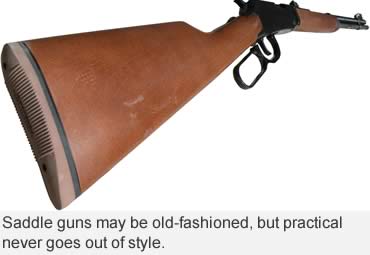 Mossberg’s Model 464 is available in .30-30 Winchester or .22 Long Rifle versions. At last look, the rimfire Model 464 listed at $468. Also discontinued, Winchester’s similar Model 9422 remains unavailable. That’s what makes the rimfire Model 464 so attractive.
Mossberg’s Model 464 is available in .30-30 Winchester or .22 Long Rifle versions. At last look, the rimfire Model 464 listed at $468. Also discontinued, Winchester’s similar Model 9422 remains unavailable. That’s what makes the rimfire Model 464 so attractive.
While I heartily applaud the effort, I was surprised at Mossberg’s new offerings. I asked Joe Bartozzi, Mossberg’s vice president and general counsel, why the company decided to step back into the past with these crank-action rifles.
“When Winchester announced its decision to halt production of its storied Model 94 and its companion Model 9422 rimfire, it created a wonderful opportunity for Mossberg,” he said. “We began gearing up when we heard the news. Our Model 464 centerfire was on the drawing board before the last Model 94 left the Winchester plant.
“The Model 464 .30-30 was introduced in 2008,” he said. “By then, the .22 version was ready for production.”
While Mossberg’s lever-action rimfire superficially resembles the Henry .22, Bartozzi emphasized the Mossberg is an all-new design. “Our rifle features a manual safety on top of the tang, a hammer block, a rebounding hammer and a safety that blocks the trigger if the lever isn’t fully closed.”
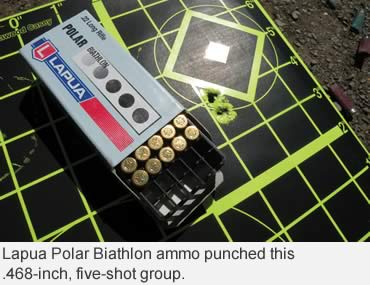 During the 1960s, Mossberg manufactured the Model 401 Palomino, a hammerless .22 lever rifle with a streamlined receiver. It was discontinued 10 years later.
During the 1960s, Mossberg manufactured the Model 401 Palomino, a hammerless .22 lever rifle with a streamlined receiver. It was discontinued 10 years later.
The company also introduced its Model 472 .30-30 lever rifle in the 1970s. It had a round bolt and solid top, similar to the design of the Marlin 336.
The Model 464 centerfire ejects empties straight up through its open-top receiver, just as the Winchester centerfire does.
The rear sight resembles a traditional semi-buckhorn sight. However, instead of changing notches in the step elevator and drifting the sight sideways in its dovetail, this sight is adjusted for windage and elevation by turning a pair of large-headed screws.
The ramped front sight is dead black. Topping the post with a copper bead would have added a few cents to the cost, but would have made the front sight more visible. The receiver is grooved for scope mounting, but I prefer my lever-action saddle guns with factory open sights. Adding a scope to a Western-style lever rifle ruins its classic looks and easy-carrying balance.
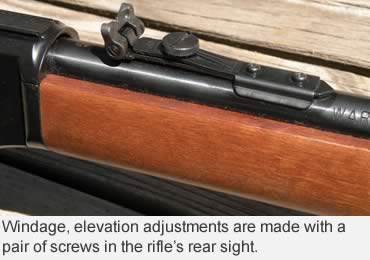 There’s no half-cock safety position on the rebounding hammer. That may upset purists, but it’s really a good idea. Pulling the hammer back to a traditional “safety notch” can provide a false sense of security. Cocked hammers may be jarred free if the rifle is dropped or struck. This rifle features a sliding tang safety immediately behind the hammer, where it falls naturally under your thumb. When this safety is engaged, you can pull the trigger to drop the hammer without causing the rifle to fire.
There’s no half-cock safety position on the rebounding hammer. That may upset purists, but it’s really a good idea. Pulling the hammer back to a traditional “safety notch” can provide a false sense of security. Cocked hammers may be jarred free if the rifle is dropped or struck. This rifle features a sliding tang safety immediately behind the hammer, where it falls naturally under your thumb. When this safety is engaged, you can pull the trigger to drop the hammer without causing the rifle to fire.
A second, separate safety prevents the rifle from firing if the operating lever isn’t pressed firmly against the stock. This happens automatically when you hold the rifle in firing position.
The rifle’s Western-style two-piece stock is walnut-dyed birch with no checkering. The pistol grip is straight, not curved. A red rubber recoil pad protects the butt and keeps the rifle from slipping on your shoulder.
The carbine-length barrel is 18 inches long, while the rifle weighs 5 1/2 pounds.
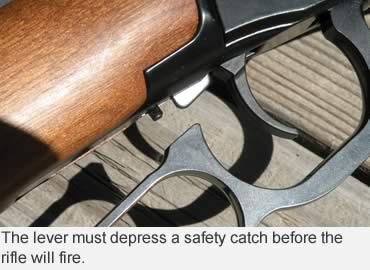 The Mossberg’s tubular magazine holds 13 rounds of Long Rifle ammunition. Some bolt- and lever-action .22s with tubular magazines can accommodate .22 Short, Long and Long Rifle ammo interchangeably.
The Mossberg’s tubular magazine holds 13 rounds of Long Rifle ammunition. Some bolt- and lever-action .22s with tubular magazines can accommodate .22 Short, Long and Long Rifle ammo interchangeably.
That was an advantage when .22 Shorts were much cheaper than they are today. Dwindling demand has made .22 Shorts more costly than the much more powerful .22 Long Rifle rounds. As a result, .22 Longs have virtually disappeared.
At the range, the 464 digested everything I fed it without malfunction. Operation was smooth and reliable. The trigger broke at a crisp 5 pounds.
The accuracy testing was done at an improvised desert range, where I set up targets and a portable bench. A hill provided a safe backstop. My son John accompanied me to help with the testing.
From a sandbagged rest, I shot six different types of .22 LR ammo. All grouped into an inch or less at 25 yards. The Lapua Polar Biathlon Match ammo delivered one five-shot group measuring .468 inch.
The gun’s black rear sight tended to meld with the equally black front sight. As noted earlier, adding a brass or copper bead to the front sights would have been a big help.
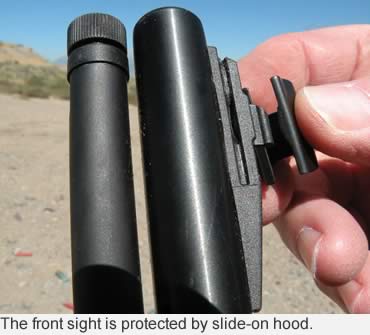 Shooting at stationary paper targets is one thing, but trying to hit a spring-legged jackrabbit is another.
Shooting at stationary paper targets is one thing, but trying to hit a spring-legged jackrabbit is another.
Over the years, I’ve developed a real fondness for hunting desert jackrabbits with lever-action .22s. The lever guns I’ve owned have all featured light weight and excellent balance. While they can’t fire follow-up shots quite as fast as a semiauto can spit them, they’re fast enough to keep pace with a racing jackrabbit.
Hunting desert jacks is a fairly straightforward affair, requiring no particular strategy. You simply move slowly through the desert, staying alert for movement or for stationary rabbits.
After covering 50 yards, I stop and scan for jacks I might have bypassed. It’s surprising how easy it is to miss jacks that freeze in place as you approach.
John and I hunted for a half hour without success. Before we gave up, I suggested we move to area nearby. It seemed equally barren of jacks until we were nearly ready to quit and call it a day.
“There’s one!” John shouted. The stationary rabbit provided an unhurried offhand shot at about 60 yards. It was a center hit, and the animal folded.
Encouraged, we walked another hundred yards or so. Another jackrabbit broke out of cover and began bounding through the sagebrush. John brought it down with his fourth shot.
“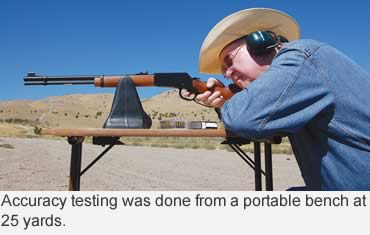 My turn,” I said, trading John the Mossberg for another .22 I’d been carrying.
My turn,” I said, trading John the Mossberg for another .22 I’d been carrying.
The little lever gun was a joy to use. It came to the shoulder almost effortlessly whenever a jack popped out of the desert scrub.
Within 10 minutes, I’d walked up three more rabbits. Two escaped the hail of 40-grain bullets. The third one tried to hide in plain sight at 40 yards.
The desert sun was heating things up, so we decided to head for the shade. We’d given the .22 a workout and were pleased with its performance. It’s good to know .22 lever rifles are still being made.
Specifications
Model: Model 464 .22
Type: Exposed Hammer Lever-Action Repeater
Caliber: 22 Long Rifle
Magazine capacity: 13 rounds
Production materials: Zinc-alloy receiver; steel barrel, bolt and lever
Sights: Fold-down rear sight adjustable for windage and elevation; bead-on-post front sight is protected by removable hood. Receiver grooved for scope mounting.
Barrel length: 18 inches
Overall length: 35 3/4 inches
Length of pull: 13 3/4 inches
Weight: 5 1/2 pounds
Stock: Two-piece birch, straight grip
Safeties: Top-tang manual safety, internal automatic safety blocks trigger unless lever is pressed against stock for firing.
MSRP: $468
Manufacturer: O.F. Mossberg & Sons Inc., 7 Grasso Ave, North Haven, CT 06473
www.mossberg.com
This article was first printed in the July 2011 edition of Buckmasters GunHunter Magazine. Subscribe today to have GunHunter delivered to your home.